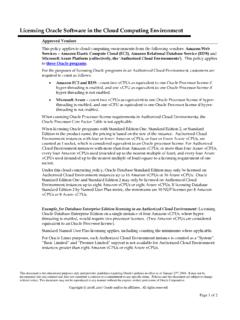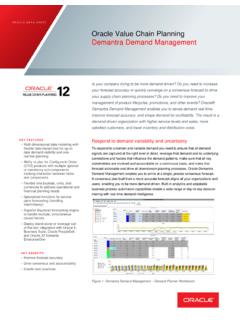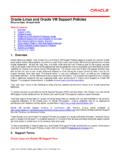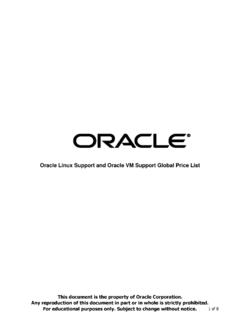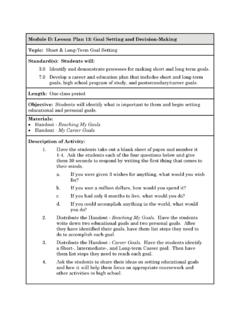Transcription of Goal Setting: A Fresh Perspective - Oracle
1 An Oracle White Paper June 2012. goal setting : A Fresh Perspective goal setting : A Fresh Perspective Introduction .. 1. The Importance of Goal Development to the Organization .. 2. Where goals Fit into the Performance Management 2. Why Are Great goals More Important than Ever to Business? .. 2. Why Are Great goals Important to Employees? .. 3. What Do Great goals Look Like? .. 4. Cascading and Aligning goals .. 5. Cascading goals .. 5. Aligning goals .. 8. Writing SMART goals .. 10. What Are SMART goals ? .. 10. A Word About Metrics .. 11. Writing SMART goals Example .. 12. Writing SMART goals Practice Worksheet .. 13. Solution: Writing SMART goals Practice Worksheet.
2 13. goals for Business Results and Employee Development .. 14. Working Together on Development goals .. 14. How goals Connect to Performance Management .. 15. Coaching for Great goals and Execution .. 17. Delivering Performance Feedback .. 19. goal setting : Putting It All 21. Goal-Setting Examples .. 21. Goal-Setting Practice Worksheet .. 21. Conclusion .. 24. goal setting : A Fresh Perspective Introduction Why is an organizational focus on goal setting so critical? An organization in which all employees understand and act upon their roles and potential to adhere to the business strategy, in which everyone is traveling in the same direction, is unstoppable. This white paper provides an overview and refresher about setting great goals .
3 Here, you'll find background and ideas on how to establish a goal-setting approach in your organization designed to guide all employees toward implementing your company's strategies. This guide is appropriate for use by human resources (HR) staff to support performance management policy making and design, by line-of-business managers to understand and execute their role in guiding their team members as they set their goals , and by individual employees as they write strong stretch goals that will help move the business forward. All of the content in this white paper is available for you to use as you see fit, with appropriate credits cited. Think about customizing the language to your organization's culture.
4 Localize the exercises and examples to your business. Make the content work for you in executing a consistent and effective goal-setting approach across your organization. 1. goal setting : A Fresh Perspective The Importance of Goal Development to the Organization The organization that makes it a priority to develop quality, effective goals will succeed in its performance management, in its business in general, and in developing its employees' skills and confidence. Where goals Fit into the Performance Management Process goals launch the annual performance journey; if you step off in the wrong direction, you'll never reach the destination you're targeting. Figure 1.
5 Setting quality goals puts employees on a multistep path toward compensation, reward, and further development. Why Are Great goals More Important than Ever to Business? goal setting , given high priority and approached consistently throughout the organization, is the mechanism by which the business delivers results against its strategy. Improved shareholder value, greater profitability, increased revenue, inspired innovation none of these can be realized without an organized process that deconstructs strategies and cascades relevant and measurable elements of those strategies appropriately through the workforce. Quality, effective goals offer significant benefits to the organization.
6 Great goals : Add a needed measure of organizational discipline that keeps everyone at every level focused on the same destination. Allow accurate forecasting of resource needs, foster the efficient use of those resources, and avoid costly stops, starts, and changes in direction. Keep the organization competitive in both the business marketplace and the employee marketplace. 2. goal setting : A Fresh Perspective Keep employees engaged because employees know what is expected of them at work. Through rigorous analysis of research conducted over 30 years with 17 million employees, Gallup identified 12 core elements that best predict employee and workgroup engagement and performance.
7 Related to these core elements, Gallup identified the Q12 high-success statements (see Figure 2). Gallup found that, among these statements, I know what is expected of me at work is fundamental. 1. These benefits are as critical to the success of small businesses as they are to large enterprises. Figure 2. goal setting is critical to achieving the Gallup Q12 statements, indicative of high performance. Why Are Great goals Important to Employees? goal setting is critically important to individuals and their managers. Gallup found that knowing what is expected of them at work was critical to employees remaining engaged in their work. Other researchers point out the additional benefits of setting high-quality goals .
8 1 Gallup, James Harter, Frank Schmidt, Emily Killham, and Sangeeta Agrawal, Q12 Meta-Analysis, The Relationship Between Engagement at Work and Organizational Outcomes, August 2009. 3. goal setting : A Fresh Perspective In A Theory of goal setting and Task Performance 2, Edwin Locke and Gary Latham cite Locke's research showing that specific and challenging goals led to better task performance than vague or easy goals . They not only confirmed the link between goals and performance at work, but they went on to outline five characteristics of an effective approach to goal setting : clarity, challenge, commitment, feedback, and task complexity. Ultimately, these principles evolved into the SMART goal-setting approach that companies are still refining today.
9 Mihaly Csikszentmihalyi reaffirmed the value of challenging activity to people in all aspects of their lives, including work. He demonstrated that people are happiest when they are in a flow state, and that happens when they are so absorbed in an activity that nothing else seems to matter strong support for specific, challenging goals . 3. How else do goals benefit employees? Making progress toward and achieving goals fosters both satisfaction and self-confidence. goals also promote planning and, along with plans, interaction between managers and direct reports and among teams to align plans, monitor milestones, and make course corrections when needed. What Do Great goals Look Like?
10 An effective and consistent approach to goal setting includes three facets: 1. goals should be, at a minimum, SMART. SMART is an acronym that stands for specific, measurable, attainable, relevant, and timely. We'll look later at ways to enrich SMART goals and customize this approach for an organization. 2. goals should be manageable in number. Five or six meaningful stretch goals are sufficient to challenge employees and keep them engaged in their contribution to the business. Adding more goals is likely to have a negative impact on productivity and derail progress toward achieving any of them. 3. goals should address both business results and personal development.
